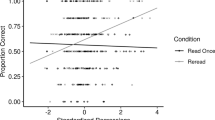Abstract
The previous studies found the differences of eye movements between systematic and heuristic processing were inconsistent. To bridge this gap, we manipulated both systematic and heuristic processings (using high vs. low distractions) and argument quality (using strong vs. weak), and measured both eye movements and self-reported attitude. The results suggested that low distraction induced larger differentiation of post-message attitude between strong and weak arguments compared to high distraction, indicating the successful operation of both processings. More importantly, low distraction enabled more fixations and shorter saccade lengths independent of argument quality. However, no differentiations were found involving fixation duration, regressions, and reading speed. In addition, argument quality influenced eye movements, i.e., less fixation and faster reading speed were found in strong arguments. Our results explain why distractions reduce the efficiency of information processing from an eye tracking perspective and why fixation duration results were inconsistent in the previous studies.

Similar content being viewed by others
References
Ares G, Mawad F, Giménez A, Maiche A (2014) Influence of rational and intuitive thinking styles on food choice: preliminary evidence from an eye-tracking study with yogurt labels. Food Qual Prefer 31:28–37
Craik FI, Lockhart RS (1972) Levels of processing: a framework for memory research. J Verbal Learn Verbal Behav 11:671–684
Day R, Lin C, Huang W, Chuang S (2009) Effects of music tempo and task difficulty on multi-attribute decision-making: an eye-tracking approach. Comput Hum Behav 25:130–143
Glöckner A, Herbold AK (2011) An eye-tracking study on information processing in risky decisions: evidence for compensatory strategies based on automatic processes. J Behav Decis Mak 24:71–98
Horstmann N, Ahlgrimm A, Glöckner A (2009) How distinct are intuition and deliberation? An eye-tracking analysis of instruction-induced decision modes. Judgm Decis Mak 5:335–354
Huang Y, Kuo F (2011) An eye-tracking investigation of internet consumers’ decision deliberateness. Internet Res 21:541–561
Irwin DE (1998) Lexical processing during saccadic eye movements. Cogn Psychol 36:1–27
Irwin DE, Carlson-Radvansky LA (1996) Cognitive suppression during saccadic eye movements. Psychol Sci 7:83–88
Jacob RJ, Karn KS (2003) Eye tracking in human–computer interaction and usability research: ready to deliver the promises. In: Hyna RR, Deubel G (eds) The mind’s eye: cognitive and applied aspects of eye movement research. North-Holland, Amsterdam, pp 573–607
Keller C, Kreuzmair C, Leins-Hess R, Siegrist M (2014) Numeric and graphic risk information processing of high and low numerates in the intuitive and deliberative decision modes: an eye-tracker study. Judgm Decis Mak 9:420–432
Lammers HB, Becker LA (1980) Distraction effects on the perceived extremity of a communication and on cognitive responses. Pers Soc Psychol Bull 6:261–266
Martin PY, Hamilton VE, McKimmie BM, Terry DJ, Martin R (2007) Effects of caffeine on persuasion and attitude change: the role of secondary tasks in manipulating systematic message processing. Eur J Soc Psychol 37:320–338
McGuire WJ (1981) The probabilogical model of cognitive structure and attitude change. In: Ostrom TM, Brock TC, Petty RE (eds) Cognitive responses in persuasion. Erlbaum, Hillsdale, pp 291–307
Morrison RE, Rayner K (1981) Saccade size in reading depends upon character spaces and not visual angle. Atten Percept Psychophys 30:395–396
Petty RE, Cacioppo JT (1986a) Attitudes and persuasion: classic and contemporary approaches. Westview Press, Boulder
Petty RE, Cacioppo JT (1986b) Communication and persuasion: central and peripheral routes to attitude change. Springer, New York
Petty RE, Krosnick JA (2014) Attitude strength: antecedents and consequences. Lawrence Erlbaum Associates, Mahwah
Petty RE, Wells GL, Brock TC (1976) Distraction can enhance or reduce yielding to propaganda: thought disruption versus effort justification. J Pers Soc Psychol 34:874–884
Rayner K (2009) Eye movements and attention in reading, scene perception, and visual search. Q J Exp Psychol A 62:1457–1506
Rubaltelli E, Dickert S, Slovic P (2012) Response mode, compatibility, and dual-processes in the evaluation of simple gambles: an eye-tracking investigation. Judgm Decis Mak 7:427–440
Salvucci DD, Goldberg JH (2000) Identifying fixations and saccades in eye-tracking protocols. In: Proceedings of the 2000 symposium on eye tracking research & applications. ACM, New York, pp 71–78
Sweller J (1988) Cognitive load during problem solving: effects on learning. Cogn Sci 12:257–285
Turner MM, Skubisz C, Pandya SP, Silverman M, Austin LL (2014) Predicting visual attention to nutrition information on food products: the influence of motivation and ability. J Health Commun 19:1017–1029
Velichkovsky BM, Rothert A, Kopf M, Dornhöfer SM, Joos M (2002) Towards an express-diagnostics for level of processing and hazard perception. Transp Res Part F Traffic Psychol Behav 5:145–156
Venkatraman V, Payne JW, Huettel SA (2014) An overall probability of winning heuristic for complex risky decisions: choice and eye fixation evidence. Organ Behav Hum Decis Process 125:73–87
Wade N, Tatler BW (2005) The moving tablet of the eye: the origins of modern eye movement research. Oxford University Press, USA
Yang S (2015) An eye-tracking study of the elaboration likelihood model in online shopping. Electron Commer Res Appl 14:233–240
Acknowledgements
This study was funded by the Major Project of Medicine Science and Technology (Grant No. AWS13J003). Author Danmin Miao has received research grants.
Author information
Authors and Affiliations
Corresponding authors
Ethics declarations
Conflict of interest
The authors declare that they have no conflict of interest.
Ethical approval
All procedures performed in studies involving human participants were in accordance with the ethical standards of the local research committee at Fourth Military Medical University and with the 1964 Helsinki Declaration and its later amendments or comparable ethical standards.
Informed consent
Informed consent was obtained from all individual participants included in the study.
Rights and permissions
About this article
Cite this article
Wu, D., Huang, H., Liu, N. et al. Information processing under high and low distractions using eye tracking. Cogn Process 20, 11–18 (2019). https://doi.org/10.1007/s10339-018-0876-3
Received:
Accepted:
Published:
Issue Date:
DOI: https://doi.org/10.1007/s10339-018-0876-3




